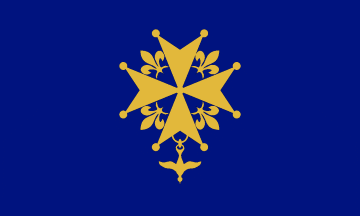
Last modified: 2025-06-07 by bruce berry
Keywords: south africa | huguenots |
Links: FOTW homepage |
search |
disclaimer and copyright |
write us |
mirrors
 image
by Olivier Touzeau, 4 February 2023
image
by Olivier Touzeau, 4 February 2023
On 31 December 1687 a group of Huguenots, a religious group of French Calvinist Protestants, set sail from France as the first of a large scale of emigration to the Cape of Good Hope which took place between 1688 and 1689. This was as a result of the Edict of Fontainebleau in 1685 which revoked the Edict of Nantes of 1598 which had granted religious toleration towards Protestants. Through the Edict of Fontainebleau, King Louis XIV ordered the destruction of Huguenot churches and the closing of Protestant schools in an attempt to intimidate the Huguenots to convert to Catholicism.
In total some 180 Huguenots from France and 18 Walloons from Belgium eventually settled at the Cape, with individual Huguenot families arriving throughout the first quarter of the 18th century after state-subsidised emigration was discontinued in 1706. Most of the Huguenot emigrants were allocated farms in an area which became known as Franschhoek ("French Corner"). Due to the Dutch East India policy that dictated that all schools teach exclusively in Dutch, that all correspondence must be in Dutch and the strict laws of assembly, the Huguenots ceased to maintain a distinctive identity and French eventually disappeared as their home language. This assimilation into the colonial population resulted in many Huguenot descendants today who are Afrikaans speaking.
Bruce Berry, 28 February 2023
A flag of the Huguenots in South Africa can be seen in
Franschhoek at the
Huguenot
Memorial Museum.
The flag has a blue background with the Huguenot cross in gold in the centre as
can be seen
here.
Huguenot is the term used to refer to those of the Reformed
Church of France from the time of the Protestant Reformation.
Today, there are some Reformed communities around the world that still
retain their Huguenot identity in the United Kingdom, the United
States, South Africa, Australia etc. In France, Calvinists in the United
Protestant Church of France and also some in the Protestant Reformed
Church of Alsace and Lorraine consider themselves Huguenots.
The Huguenot Cross is the distinctive emblem of the Huguenots. It is
now an official symbol of the Église des Protestants réformés (French
Protestant Church). Huguenot descendants sometimes display this symbol
as a sign of recognition between them.
The Huguenot Cross appeared in southern France at the end of the 17th
century and came into general use among 19th century Huguenot
descendants in countries where Huguenot refugees settled as a sign of
both identification with French Huguenot ancestry and confirmation of
the wearer's faith.
The emblem comprises:
Olivier Touzeau, 4 February 2023